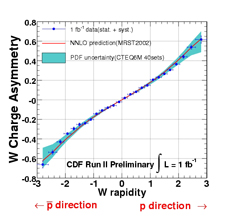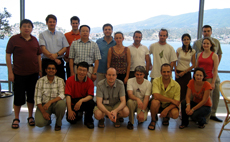Getting a charge from asymmetry

The W charge asymmetry versus the W rapidity for the data (black points). The red curve shows the predicted asymmetry and the blue band shows the uncertainty of that prediction due to the uncertainty in the proton parton distribution functions.
Protons are composed of two up quarks and a down quark and are bound together by the strong force via gluons. In order to explore the structure of the proton, we make measurements of the momentum distributions of quarks and gluons in the proton. This is called the parton distribution function, or PDF. Many analyses at a hadron collider suffer from systematic uncertainties from our limited knowledge of PDFs.
At the Tevatron, one measurement of proton PDFs comes from the W production charge asymmetry. W bosons are produced when the up and down quarks inside the proton and antiproton collide. An asymmetry between W+ and W- arises due to differences in the up quark versus down quark PDFs. The up quark tends to carry a higher fraction of the proton's momentum than the down quark, so the W+(W-) tends to follow the initial direction of the proton or antiproton.
Scientists on the CDF experiment have developed a new analysis technique that measures the charge asymmetry as a function of the direction of the W itself -- measured by a quantity called W rapidity -- as opposed to that of the observed electron from W decay. They measured the W charge asymmetry, the difference in the W+ and W- produced, divided by the total vs. the W rapidity, using 1 inverse femtobarn of data. Since the uncertainties on this measurement are smaller than the current uncertainties on the PDFs, this measurement will provide an improved understanding of the internal structure of the proton.
Learn more

Clockwise from top left : Bo-Young Han, University of Rochester; Eva Halkiadakis, Rutgers University; Kevin McFarland, University of Rochester; Arie Bodek, University of Rochester; YeonSei Chung, University of Rochester.
Result of the Week Archive
|



